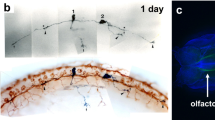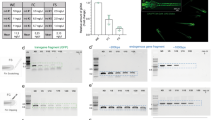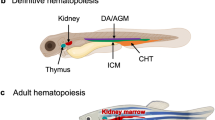Abstract
Zebrafish has many advantages as a model of human pediatric research. Given the physical and ethical problems with performing experiments on human patients, biomedical research has focused on using model organisms to study biologic processes conserved between humans and lower vertebrates. The most common model organisms are small mammals, usually rats and mice. Although these models have significant advantages, they are also expensive to maintain, difficult to manipulate embryonically, and limited for large-scale genetic studies. The zebrafish model nicely complements these deficiencies in mammalian experimental models. The low cost, small size, and external development of zebrafish make it an excellent model for vertebrate development biology. Techniques for large-scale genome mutagenesis and gene mapping, transgenesis, protein overexpression or knockdown, cell transplantation and chimeric embryo analysis, and chemical screens have immeasurably increased the power of this model organism. It is now possible to rapidly determine the developmental function of a gene of interest in vivo, and then identify genetic and chemical modifiers of the processes involved. Discoveries made in zebrafish can be further validated in mammals. With novel technologies being regularly developed, the zebrafish is poised to significantly improve our understanding of vertebrate development under normal and pathologic conditions.
Similar content being viewed by others
Log in or create a free account to read this content
Gain free access to this article, as well as selected content from this journal and more on nature.com
or
Abbreviations
- ENU:
-
N-ethyl-N-nitrosurea
- IMPDH:
-
inosine monophosphate dehydrogenase
- ISH:
-
in situ hybridization
- HSC:
-
hematopoetic stem cell
- MPA:
-
mycophenolic acid
- TILLING:
-
targeting induced local lesions IN genomes
- UROD :
-
uroporphyrinogen decarboxylase
References
Sumanas S, Jorniak T, Lin S 2005 Identification of novel vascular endothelial-specific genes by the microarray analysis of the zebrafish cloche mutants. Blood 106: 534–541
Qian F, Zhen F, Ong C, Jin SW, Meng Soo H, Stainier DY, Lin S, Peng J, Wen Z 2005 Microarray analysis of zebrafish cloche mutant using amplified cDNA and identification of potential downstream target genes. Dev Dyn 233: 1163–1172
Weber GJ, Choe SE, Dooley KA, Paffett-Lugassy NN, Zhou Y, Zon LI 2005 Mutant-specific gene programs in the zebrafish. Blood 106: 521–530
Sumanas S, Lin S 2006 Ets1-related protein is a key regulator of vasculogenesis in zebrafish. PLoS Biol 4: e10
Pham VN, Lawson ND, Mugford JW, Dye L, Castranova D, Lo B, Weinstein BM 2007 Combinatorial function of ETS transcription factors in the developing vasculature. Dev Biol 303: 772–783
Sumanas S, Gomez G, Zhao Y, Park C, Choi K, Lin S 2008 Interplay among Etsrp/ER71, Scl, and Alk8 signaling controls endothelial and myeloid cell formation. Blood 111: 4500–4510
Lee D, Park C, Lee H, Lugus JJ, Kim SH, Arentson E, Chung YS, Gomez G, Kyba M, Lin S, Janknecht R, Lim DS, Choi K 2008 ER71 acts downstream of BMP, Notch, and Wnt signaling in blood and vessel progenitor specification. Cell Stem Cell 2: 497–507
Jowett T, Yan YL 1996 Double fluorescent in situ hybridization to zebrafish embryos. Trends Genet 12: 387–389
Thisse C, Thisse B 2008 High-resolution in situ hybridization to whole-mount zebrafish embryos. Nat Protoc 3: 59–69
Streisinger G, Walker C, Dower N, Knauber D, Singer F 1981 Production of clones of homozygous diploid zebra fish (Brachydanio rerio). Nature 291: 293–296
Westerfield M 2000 The Zebrafish Book. Eugene, Oregon, The University of Oregon Press.
Driever W, Solnica-Krezel L, Schier AF, Neuhauss SC, Malicki J, Stemple DL, Stainier DY, Zwartkruis F, Abdelilah S, Rangini Z, Belak J, Boggs C 1996 A genetic screen for mutations affecting embryogenesis in zebrafish. Development 123: 37–46
Haffter P, Granato M, Brand M, Mullins MC, Hammerschmidt M, Kane DA, Odenthal J, van Eeden FJ, Jiang YJ, Heisenberg CP, Kelsh RN, Furutani-Seiki M, Vogelsang E, Beuchle D, Schach U, Fabian C, Nusslein-Volhard C 1996 The identification of genes with unique and essential functions in the development of the zebrafish, Danio rerio. Development 123: 1–36
Grunwald DJ, Streisinger G 1992 Induction of recessive lethal and specific locus mutations in the zebrafish with ethyl nitrosourea. Genet Res 59: 103–116
Solnica-Krezel L, Schier AF, Driever W 1994 Efficient recovery of ENU-induced mutations from the zebrafish germline. Genetics 136: 1401–1420
Allende ML, Amsterdam A, Becker T, Kawakami K, Gaiano N, Hopkins N 1996 Insertional mutagenesis in zebrafish identifies two novel genes, pescadillo and dead eye, essential for embryonic development. Genes Dev 10: 3141–3155
Wang D, Jao LE, Zheng N, Dolan K, Ivey J, Zonies S, Wu X, Wu K, Yang H, Meng Q, Zhu Z, Zhang B, Lin S, Burgess SM 2007 Efficient genome-wide mutagenesis of zebrafish genes by retroviral insertions. Proc Natl Acad Sci USA 104: 12428–12433
Nagayoshi S, Hayashi E, Abe G, Osato N, Asakawa K, Urasaki A, Horikawa K, Ikeo K, Takeda H, Kawakami K 2008 Insertional mutagenesis by the Tol2 transposon-mediated enhancer trap approach generated mutations in two developmental genes: tcf7 and synembryn-like. Development 135: 159–169
Ransom DG, Haffter P, Odenthal J, Brownlie A, Vogelsang E, Kelsh RN, Brand M, van Eeden FJ, Furutani-Seiki M, Granato M, Hammerschmidt M, Heisenberg CP, Jiang YJ, Kane DA, Mullins MC, Nusslein-Volhard C 1996 Characterization of zebrafish mutants with defects in embryonic hematopoiesis. Development 123: 311–319
Wang H, Long Q, Marty SD, Sassa S, Lin S 1998 A zebrafish model for hepatoerythropoietic porphyria. Nat Genet 20: 239–243
Lambrecht RW, Thapar M, Bonkovsky HL 2007 Genetic aspects of porphyria cutanea tarda. Semin Liver Dis 27: 99–108
Kim HJ, Sumanas S, Palencia-Desai S, Dong Y, Chen JN, Lin S 2006 Genetic analysis of early endocrine pancreas formation in zebrafish. Mol Endocrinol 20: 194–203
Long Q, Meng A, Wang H, Jessen JR, Farrell MJ, Lin S 1997 GATA-1 expression pattern can be recapitulated in living transgenic zebrafish using GFP reporter gene. Development 124: 4105–4111
Jessen JR, Meng A, McFarlane RJ, Paw BH, Zon LI, Smith GR, Lin S 1998 Modification of bacterial artificial chromosomes through chi-stimulated homologous recombination and its application in zebrafish transgenesis. Proc Natl Acad Sci USA 95: 5121–5126
Balciunas D, Davidson AE, Sivasubbu S, Hermanson SB, Welle Z, Ekker SC 2004 Enhancer trapping in zebrafish using the sleeping beauty transposon. BMC Genomics 5: 62
Parinov S, Kondrichin I, Korzh V, Emelyanov A 2004 Tol2 transposon-mediated enhancer trap to identify developmentally regulated zebrafish genes in vivo. Dev Dyn 231: 449–459
Finley KR, Davidson AE, Ekker SC 2001 Three-color imaging using fluorescent proteins in living zebrafish embryos. Biotechniques 31: 66–70, 72
Hall C, Flores MV, Storm T, Crosier K, Crosier P 2007 The zebrafish lysozyme C promoter drives myeloid-specific expression in transgenic fish. BMC Dev Biol 7: 42
Covassin L, Amigo JD, Suzuki K, Teplyuk V, Straubhaar J, Lawson ND 2006 Global analysis of hematopoietic and vascular endothelial gene expression by tissue specific microarray profiling in zebrafish. Dev Biol 299: 551–562
Holder N, Xu Q 1999 Microinjection of DNA, RNA, and protein into the fertilized zebrafish egg for analysis of gene function. Methods Mol Biol 97: 487–490
Halloran MC, Sato-Maeda M, Warren JT, Su F, Lele Z, Krone PH, Kuwada JY, Shoji W 2000 Laser-induced gene expression in specific cells of transgenic zebrafish. Development 127: 1953–1960
Hardy ME, Ross LV, Chien CB 2007 Focal gene misexpression in zebrafish embryos induced by local heat shock using a modified soldering iron. Dev Dyn 236: 3071–3076
Scheer N, Campos-Ortega JA 1999 Use of the Gal4-UAS technique for targeted gene expression in the zebrafish. Mech Dev 80: 153–158
Langenau DM, Feng H, Berghmans S, Kanki JP, Kutok JL, Look AT 2005 Cre/lox-regulated transgenic zebrafish model with conditional myc-induced T cell acute lymphoblastic leukemia. Proc Natl Acad Sci USA 102: 6068–6073
Thummel R, Burket CT, Brewer JL, Sarras MP Jr Li L, Perry M, McDermott JP, Sauer B, Hyde DR, Godwin AR 2005 Cre-mediated site-specific recombination in zebrafish embryos. Dev Dyn 233: 1366–1377
Pan X, Wan H, Chia W, Tong Y, Gong Z 2005 Demonstration of site-directed recombination in transgenic zebrafish using the Cre/loxP system. Transgenic Res 14: 217–223
Kawakami K, Shima A, Kawakami N 2000 Identification of a functional transposase of the Tol2 element, an Ac-like element from the Japanese medaka fish, and its transposition in the zebrafish germ lineage. Proc Natl Acad Sci USA 97: 11403–11408
Kawakami K 2007 Tol2: a versatile gene transfer vector in vertebrates. Genome Biol 8: S7
Villefranc JA, Amigo J, Lawson ND 2007 Gateway compatible vectors for analysis of gene function in the zebrafish. Dev Dyn 236: 3077–3087
Kwan KM, Fujimoto E, Grabher C, Mangum BD, Hardy ME, Campbell DS, Parant JM, Yost HJ, Kanki JP, Chien CB 2007 The Tol2kit: a multisite gateway-based construction kit for Tol2 transposon transgenesis constructs. Dev Dyn 236: 3088–3099
Langenau DM, Traver D, Ferrando AA, Kutok JL, Aster JC, Kanki JP, Lin S, Prochownik E, Trede NS, Zon LI, Look AT 2003 Myc-induced T cell leukemia in transgenic zebrafish. Science 299: 887–890
Langenau DM, Keefe MD, Storer NY, Guyon JR, Kutok JL, Le X, Goessling W, Neuberg DS, Kunkel LM, Zon LI 2007 Effects of RAS on the genesis of embryonal rhabdomyosarcoma. Genes Dev 21: 1382–1395
Yeh JR, Munson KM, Chao YL, Peterson QP, Macrae CA, Peterson RT 2008 AML1-ETO reprograms hematopoietic cell fate by downregulating scl expression. Development 135: 401–410
Nasevicius A, Ekker SC 2000 Effective targeted gene ‘knockdown' in zebrafish. Nat Genet 26: 216–220
Draper BW, Morcos PA, Kimmel CB 2001 Inhibition of zebrafish fgf8 pre-mRNA splicing with morpholino oligos: a quantifiable method for gene knockdown. Genesis 30: 154–156
Robu ME, Larson JD, Nasevicius A, Beiraghi S, Brenner C, Farber SA, Ekker SC 2007 p53 activation by knockdown technologies. PLoS Genet 3: e78
Eisen JS, Smith JC 2008 Controlling morpholino experiments: don't stop making antisense. Development 135: 1735–1743
Choi WY, Giraldez AJ, Schier AF 2007 Target protectors reveal dampening and balancing of Nodal agonist and antagonist by miR-430. Science 318: 271–274
Hildebrandt F, Zhou W 2007 Nephronophthisis-associated ciliopathies. J Am Soc Nephrol 18: 1855–1871
Sayer JA, Otto EA, O'Toole JF, Nurnberg G, Kennedy MA, Becker C, Hennies HC, Helou J, Attanasio M, Fausett BV, Utsch B, Khanna H, Liu Y, Drummond I, Kawakami I, Kusakabe T, Tsuda M, Ma L, Lee H, Larson RG, Allen SJ, Wilkinson CJ, Nigg EA, Shou C, Lillo C, Williams DS, Hoppe B, Kemper MJ, Neuhaus T, Parisi MA, Glass IA, Petry M, Kispert A, Gloy J, Ganner A, Walz G, Zhu X, Goldman D, Nurnberg P, Swaroop A, Leroux MR, Hildebrandt F 2006 The centrosomal protein nephrocystin-6 is mutated in Joubert syndrome and activates transcription factor ATF4. Nat Genet 38: 674–681
Zhao Y, Yang Z, Phelan JK, Wheeler DA, Lin S, McCabe ER 2006 Zebrafish dax1 is required for development of the interrenal organ, the adrenal cortex equivalent. Mol Endocrinol 20: 2630–2640
McCabe ER 2007 DAX1: increasing complexity in the roles of this novel nuclear receptor. Mol Cell Endocrinol 265–266: 179–182
Wienholds E, Schulte-Merker S, Walderich B, Plasterk RH 2002 Target-selected inactivation of the zebrafish rag1 gene. Science 297: 99–102
Wienholds E, van Eeden F, Kosters M, Mudde J, Plasterk RH, Cuppen E 2003 Efficient target-selected mutagenesis in zebrafish. Genome Res 13: 2700–2707
Ho RK, Kane DA 1990 Cell-autonomous action of zebrafish spt-1 mutation in specific mesodermal precursors. Nature 348: 728–730
Carmany-Rampey A, Moens CB 2006 Modern mosaic analysis in the zebrafish. Methods 39: 228–238
Piotrowski T, Ahn DG, Schilling TF, Nair S, Ruvinsky I, Geisler R, Rauch GJ, Haffter P, Zon LI, Zhou Y, Foott H, Dawid IB, Ho RK 2003 The zebrafish van gogh mutation disrupts tbx1, which is involved in the DiGeorge deletion syndrome in humans. Development 130: 5043–5052
Hay BN 2007 Deletion 22q11: spectrum of associated disorders. Semin Pediatr Neurol 14: 136–139
Piotrowski T, Schilling TF, Brand M, Jiang YJ, Heisenberg CP, Beuchle D, Grandel H, van Eeden FJ, Furutani-Seiki M, Granato M, Haffter P, Hammerschmidt M, Kane DA, Kelsh RN, Mullins MC, Odenthal J, Warga RM, Nusslein-Volhard C 1996 Jaw and branchial arch mutants in zebrafish II: anterior arches and cartilage differentiation. Development 123: 345–356
Nicoli S, Ribatti D, Cotelli F, Presta M 2007 Mammalian tumor xenografts induce neovascularization in zebrafish embryos. Cancer Res 67: 2927–2931
Haldi M, Ton C, Seng WL, McGrath P 2006 Human melanoma cells transplanted into zebrafish proliferate, migrate, produce melanin, form masses and stimulate angiogenesis in zebrafish. Angiogenesis 9: 139–151
Lee LM, Seftor EA, Bonde G, Cornell RA, Hendrix MJ 2005 The fate of human malignant melanoma cells transplanted into zebrafish embryos: assessment of migration and cell division in the absence of tumor formation. Dev Dyn 233: 1560–1570
Stoletov K, Montel V, Lester RD, Gonias SL, Klemke R 2007 High-resolution imaging of the dynamic tumor cell vascular interface in transparent zebrafish. Proc Natl Acad Sci USA 104: 17406–17411
White RM, Sessa A, Burke C, Bowman T, LeBlanc J, Ceol C, Bourque C, Dovey M, Goessling W, Burns CE, Zon LI 2008 Transparent adult zebrafish as a tool for in vivo transplantation analysis. Cell Stem Cell 2: 183–189
Zon LI, Peterson RT 2005 In vivo drug discovery in the zebrafish. Nat Rev Drug Discov 4: 35–44
Carvan MJ III Dalton TP, Stuart GW, Nebert DW 2000 Transgenic zebrafish as sentinels for aquatic pollution. Ann N Y Acad Sci 919: 133–147
Milan DJ, Peterson TA, Ruskin JN, Peterson RT, MacRae CA 2003 Drugs that induce repolarization abnormalities cause bradycardia in zebrafish. Circulation 107: 1355–1358
Langheinrich U 2003 Zebrafish: a new model on the pharmaceutical catwalk. Bioessays 25: 904–912
Chiu LL, Cunningham LL, Raible DW, Rubel EW, Ou HC 2008 Using the zebrafish lateral line to screen for ototoxicity. J Assoc Res Otolaryngol 9: 178–190
Wu X, Zhong H, Song J, Damoiseaux R, Yang Z, Lin S 2006 Mycophenolic acid is a potent inhibitor of angiogenesis. Arterioscler Thromb Vasc Biol 26: 2414–2416
North TE, Goessling W, Walkley CR, Lengerke C, Kopani KR, Lord AM, Weber GJ, Bowman TV, Jang IH, Grosser T, Fitzgerald GA, Daley GQ, Orkin SH, Zon LI 2007 Prostaglandin E2 regulates vertebrate haematopoietic stem cell homeostasis. Nature 447: 1007–1011
Author information
Authors and Affiliations
Corresponding author
Additional information
Supported by an NIH postdoctoral training grant in Developmental Hematology, T32 HL08634 (M.B.V.); NIH grant DK54508 (S.L.).
Developmental Biology: Model Systems - A Series of Reviews
In this the second of five review articles focusing on model organisms currently being studied to understand developmental mechanisms Drs. Veldman and Lin examine the Zebrafish model. This model is a particularly useful system for advancing our understanding of the genetic mechanisms involved in vertebrate development.
Sherin U. Devaskar, M.D.
Editor-in-Chief
Rights and permissions
About this article
Cite this article
Veldman, M., Lin, S. Zebrafish as a Developmental Model Organism for Pediatric Research. Pediatr Res 64, 470–476 (2008). https://doi.org/10.1203/PDR.0b013e318186e609
Received:
Accepted:
Issue date:
DOI: https://doi.org/10.1203/PDR.0b013e318186e609
This article is cited by
-
Myelin toxicity of chlorhexidine in zebrafish larvae
Pediatric Research (2023)
-
Enhancement of zebrafish sperm production via a large body-sized surrogate with germ cell transplantation
Communications Biology (2023)
-
Zebrafish as a Model for Osteoporosis: Functional Validations of Genome-Wide Association Studies
Current Osteoporosis Reports (2023)
-
A minimally invasive fin scratching protocol for fast genotyping and early selection of zebrafish embryos
Scientific Reports (2022)
-
The Zebrafish model in dermatology: an update for clinicians
Discover Oncology (2022)



